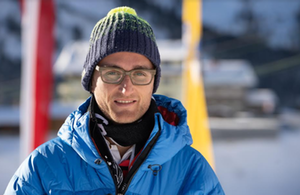The FIL Luge World Cup 2018/19 on Natural Track is history after 7 races in 6 different locations. After the kick-off in Kühtai (AUT) in December the World Cup-Tour continued in Winterleiten (AUT) in January, followed by the double World Cup in Moscow (RUS), via Deutschnofen (ITA) and Vatra Dornei (ROU) to Umhausen (AUT). In February there was the World Championship in Latzfons (ITA). In the juniors, the highlight of the season was the Junior European Championship in Umhausen at the end of February. We met FIL Sport Director Andreas Castiglioni for a season-closing interview.

Mr. Castiglioni, already the kick-off in Kühtai had to be delayed for two weeks, than Winterleiten had to step in as substitute for Sankt Sebastian. Despite the adverse circumstances with record amounts of snow, etc., no World Cup had to be cancelled. How is your balance sheet?
It was an extremely intense season, a lot has gone haywire. It was a wild ride, we often had to react at the last moment to the new circumstances, sometimes we had to intervene even on site. Nevertheless we could do every race. But this is only possible if you have a powerful staff by your side. In such situations you can see what is possible when everyone pulls together!
The FIL works hard to increase the importance of Natural Track Luge and increase visibility.
The media presence was very positive last winter, from television to the press to online and social media. The livestream visitors of the competitions marked a plus of 25%! There were accesses worldwide, from all continents. And also the number of spectators on site was impressive, especially at the World Championship in Latzfons and the World Cup in Deutschnofen.
Athletes from a total number of 22 nations participated in the World Cup 2018/19, at the World Championship athletes from 23 nations were at the start. Satisfied with this numbers?
Every year a few athletes drop out because they end their careers, but others drop in. It is always very important to me to keep the benchmark of 20 nations. This is a success of the years of constant work of the FIL Group.
In the team competition, 10 nations have received prize money for the first time, and instead of doubles, there were 3 singles. Is this the right way?
The team competition is not quite mature yet, but the changes were important and correct. We are already thinking about a further development. I can not say anything about the options yet, they have to be discussed first in the commission.
Italy was the dominant nation last winter, the “Azzurri” won all gold medals at the home World Championship, and Evelin Lanthaler won all the races in the women's competition. Isn’t that monotonous?
I would say, at the World Championship Italy has just exploited the home advantage, which is legitimate. On the other hand the athletes had more pressure. In the World Cup, it was very exciting, in men’s single we had a tight battle from the first to the last race and we had 3 different winners. The question of whether Lanthaler will win all 7 races was extremely exciting, because Lanthaler was in second position 3 times after the first run.
In Deutschnofen we had a mirror-smooth track and in Vatra Dornei for example a bumpy, rustic track. Both are legitimate, but both species are not undisputed. In which direction will it go in the future?
That's natural luge. Nature dictates the conditions, the weather and the temperatures influence the conditions on the track and this is exactly the attraction in this sport. The athletes have to adapt to different conditions and coordinate the material. Sometimes the ice is smooth, sometimes soft and sometimes it is bumpy.
Most of the races take place in Austria and Italy. Will there be more races in other countries in the future?
That is indeed a small flaw. The simple reason is that in Austria and Italy we have very experienced people who can easily organize a World Cup. For 2019/20 races are planned in Russia and Slovenia, Slovakia and Romania are also interested in World Cup races, and such considerations are also in Poland and overseas.
The Junior World Cup was very attractive, the Junior European Championship offered a very high level. How is the luge junior sector developing?
The Junior World Cup has grown out of its infancy, we started with 6/7 nations and have now arrived at 17/18 nations, that's strong! Especially in the Alps we have many young lugers, because natural track is a nature-related and affordable sport. Snow and ice are (almost) everywhere in the world.
What is on the FIL agenda for the summer months? What needs to be done before the start of the new World Cup season?
In the middle of March we close the old season. In mid-April it will continue with the committee meetings, the preparation for the congress in Slovenia and with the preparations for the coming winter. The season opener in mid-December is just around the corner.









